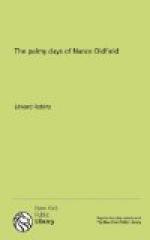[Footnote A: See Ashton’s “Social Life in the Reign of Queen Anne.”]
All this may have a curious interest, but it looks a trifle inconsistent, does it not, to lament the unjustness of connecting puppet entertainments and the like with the stage, and then deliberately devote space to the mysteries of Bartholomew Fair? It is more to the purpose to speak of the two theatres which claimed the attention of London playgoers in the year 1703—the Theatre Royal, Drury Lane, and the house in Lincoln’s Inn Fields.
Of the two, Drury Lane was the more important in an historical sense, having been the house of the famous “King’s Company,” as the players of Charles II. were styled, and then of the combined forces formed in 1682 by the union of this organisation and the “Duke of York’s Company.” This was the house into which Nance Oldfield came as a modest debutante. It had been built from the designs of Wren, to replace the old theatre destroyed by fire in 1672.
Cibber has sketched for us the second Drury Lane’s interior, as it appeared in its original form, before the making of changes intended to enlarge the seating capacity. “It must be observed then, that the area or platform of the old stage projected about four feet forwarder (sic), in a semi-oval figure, parallel to the benches of the pit; and that the former lower doors of entrance for the actors were brought down between the two foremost (and then only) pilasters; in the place of which doors now the two stage boxes are fixt. That where the doors of entrance now are, there formerly stood two additional side-wings, in front to a full set of scenes, which had then almost a double effect in their loftiness and magnificence.
“By this original form, the usual station of the actors, in almost every scene, was advanc’d at least ten foot nearer to the audience than they now can be; because, not only from the stage’s being shorten’d in front, but likewise from the additional interposition of those stage boxes, the actors (in respect to the spectators that fill them) are kept so much more backward from the main audience than they us’d to be. But when the actors were in possession of that forwarder space to advance upon, the voice was then more in the centre of the house, so that the most distant ear had scarce the least doubt or difficulty in hearing what fell




